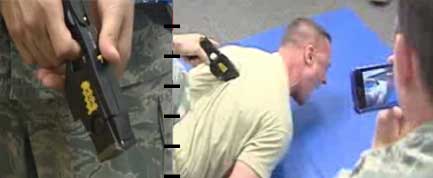Air Force Troops Laugh as Comrades Get Zapped by Taser

The Air Force recently released a video of airmen shocking each other with Tasers during a training exercise. Air Force leaders want the airmen to feel the effects of the nonlethal weapon firsthand so they can better judge its appropriate use, said a man identified as Staff Sgt. Brandon Phelps in the video.
On base, the airmen take a course on Taser safety and proper use of these weapons. For a final exam of sorts, they use the weapons on each other.
This class is the first in what the Air Force hopes will be a large contingent of base guards certified to use a Taser. Certification requires that the students retake the class every year.
But the video also reveals something interesting about human nature. As the testing proceeded and each man was shocked, and was clearly suffering intense pain, others in the group burst out laughing.
In this video, the Air Force has, perhaps unwittingly, documented the key role humor plays in group bonding and in an individual's self image. Additionally, the video highlights the roots of humor in surprise, and the subconscious nature of slapstick, according to psychologists.
Humor serves many purposes, but establishing status within a group is one of the most important, said Aaron Kozbelt, a professor of psychology and humor specialist at Brooklyn College in New York. By laughing at their comrade getting zapped, the other airmen distance themselves from their less fortunate colleague, and thus appear more capable by comparison, Kozbelt said.
"In terms of things like slapstick and the Taser," Kozbelt told LiveScience, "If one person looks bad, we all look better. Spontaneously laughter is a manifestation of that."
Get the world’s most fascinating discoveries delivered straight to your inbox.
Another reason for laughter at scenes like these is the element of surprise. Even small children innately understand that the brain thinks and the body follows, Kozbelt said, so somebody shaking and falling over without visible explanation provokes laughter because it spontaneously and surprisingly contradicts that understanding.
“A lot of discussion of humor has hinged on the surprise factor. There has to be some expectation that is violated,” Kozbelt said. There may just be something intrinsically amusing about seeing the body of someone acting out of control, he said.
For the most part, the humor of slapstick affects an unconscious part of the mind, as opposed to the more intellectual response elicited by a pun or by satire, Kozbelt said. So the Airmen probably didn't even realize they were laughing when the first of their classmates fell flopping to the floor in hysterics, which limits any explanations of what really makes the whole incident funny.
"Something like this tasing incident," Kozbelt, said, "Where the humor is nonverbal, where there's no nuance of meaning that needs to be unpacked, taps into something much more basic."
- Video - Taser Agony Felt Firsthand in Air Force Training
- Why Do I Laugh at Funny Things?
- Top 10 Mysteries of the Mind
{{ video="LS_100518_TaserTraining" title="Taser Agony Felt Firsthand in Air Force Training" caption="U.S. Air Force security trainees experience the pain of a taser device they may someday be called upon to used on someone else. The weapon induces torturous muscle contractions. Credit: USAF." }}


